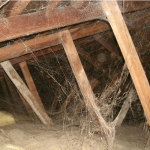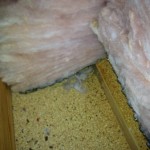 The attic is one of the most challenging areas of any home to treat for pests. All you have to do is stick your head up in the entry on a warm summers day and you’ll quickly find out the # 1 reason why. The 120 degree heat is something that hinders even the hardiest of technicians and it will absolutely stop most DIY homeowners in their tracks. However, even if you decide to head on up into this expanse in the cool of the morning or late in the evening to escape the sweltering environment, you’re still faced with the challenge of traipsing the maze of beams and trusses. Add the fact you’re most likely carrying a fogger or two, maybe a duster or sprayer and this can be a recipe for disaster.
The attic is one of the most challenging areas of any home to treat for pests. All you have to do is stick your head up in the entry on a warm summers day and you’ll quickly find out the # 1 reason why. The 120 degree heat is something that hinders even the hardiest of technicians and it will absolutely stop most DIY homeowners in their tracks. However, even if you decide to head on up into this expanse in the cool of the morning or late in the evening to escape the sweltering environment, you’re still faced with the challenge of traipsing the maze of beams and trusses. Add the fact you’re most likely carrying a fogger or two, maybe a duster or sprayer and this can be a recipe for disaster.
Well in the spirit of good news bad news–that description was the good. The bad news, is that most efforts (at least the ones I see) fail to produce any real results. Spiders simply slink back into their web lined holes while silverfish, ants, roaches and the like retreat to the underside of the 6 to 10 inches of life preserving insulation. No fog, dust or spray in the world will get to anything there. Then once the relentless heat zaps the pesticides strength, life goes right back to normal for the pest, no worse for the wear.
To be for sure, successful attic treatments are still a challenge for pro or DIY alike even with some of the best equipment. Here are just a few of my thoughts and things you might do to make your attic treatment as effective as it can be.
Do Foggers Work In An Attic?
I’m not a big fan of foggers in the attic. The biggest reason is simply safety. If you’ve ever clicked the trigger button of a fogger you know just how quickly that little bomb goes off. The problem is most people want to put two or three up there and of course space them out. So they straddle over a couple trusses, maybe some duct work and “click”, the race is on. Wanting (understandably) to get out of the spew, they try and hustle out to spot #2 where they soon realize, the fog is beating them there. So a panic of sorts sets in and now they really start moving. The obvious danger is they make a mis step and fall through the ceiling. Another potentially big problem is that the hurried treater doesn’t set the can up properly and it falls over or is misaimed entirely and perhaps douses it’s entire contents on an unintended target. An air duct or recessed lighting fixture can get hosed by the entire contents of that little can and the results of something like that can’t be good.
you know just how quickly that little bomb goes off. The problem is most people want to put two or three up there and of course space them out. So they straddle over a couple trusses, maybe some duct work and “click”, the race is on. Wanting (understandably) to get out of the spew, they try and hustle out to spot #2 where they soon realize, the fog is beating them there. So a panic of sorts sets in and now they really start moving. The obvious danger is they make a mis step and fall through the ceiling. Another potentially big problem is that the hurried treater doesn’t set the can up properly and it falls over or is misaimed entirely and perhaps douses it’s entire contents on an unintended target. An air duct or recessed lighting fixture can get hosed by the entire contents of that little can and the results of something like that can’t be good.
Having said this, I do fog attics but we use a professional machine that billows out a cloud of material (don’t let the description fool you–it’s not that much) and in most cases it can all be done right from the entry. The “directional” aspect of a professional fog machine is what I believe makes the difference. The fan pushes out the non residual plume in a forceful manner and so deep areas of the attic are easily treated and filled as opposed to the 6 ounce fogger whose contents barely gets a nudge. As stated above, no fog in the world will get to those pests who make it to or are safe already ‘under’ the insulation but those on the surface, usually wind up dead.
Does Dusting Work In An Attic?
The short answer is yes and it is far more long lived than fog and is very effective on spiders it comes in contact with. The problem, (oh why so many problems?) is that you’re going to have to maneuver through the attic in order to apply it. Before I go further–there are ‘power dusters’ and you could treat an entire attic much the same as with a fog machine. My hesitancy there is that this big cloud of dust doesn’t dissipate like a fog and the powder settles on top of EVERYTHING it touches. That might not matter to you, you solved the problem and that dust will last quite sometime ready to kill future pests. However it WILL MATTER to the cable or alarm tech that has to go up there next week, next month or whenever. With each step he or she takes they stir up the dust and breathe it in. Not good. There was a company in my town that dusted attics routinely, that is until they were sued and I think the total in clean up and punitive damages was more than $25 k. Far better to put a head lamp on and take a puff duster perhaps with an extension and see what kind of damage you can do. (to the pests) If I do dust an attic now days that’s how I do it with special attention to the spider holes, underside of insulation in the entry area and/or the area where pests were noted on the floor below. ie. a light fixture or bathroom fan area. It’s more difficult for sure but direct and very effective.
Does Spraying Work In An Attic?
Well I guess it does but I’m not a fan at all of liquid sprays in such an area. Your biggest 2 enemies are gravity and heat. 3rd I guess would be trying to lug even a one gallon sprayer around amongst the trusses. Heat breaks down all sorts of things and household pest sprays are no match for it. What doesn’t get soaked into the 2×4’s and then becomes forever harmless, the rest gets boiled away with the relentless heat. If you do have a mass of ants let’s say, then a fan spray shot of liquid from your B&G will be fine but that’s about it. There are WP’s (wettable powders) or borates that’ll work and at times you need these for WDO’s (wood destroying insects/organisms) but without the proper equipment you can make a real mess. Best to leave that job up to the pros. The other foe is gravity. Heavy spraying can damage insulation and drywall quickly. For me, I rarely use liquids in an attic for these reasons.
Does Baiting Work In An Attic?
Ah, now you’re cooking. It only took me about 30 years to figure this out so don’t feel bad if this is news to you. Baiting in an attic is by far one of the best things you can do. Now gel baits won’t work very well for obvious reasons of melting but certain scatter baits are perfect for just such a treatment. I use Niban granule baits myself. I can put the Niban FG in my puff duster for the attic entry and/or storage areas and get those pesky silverfish or roaches that are living in the Christmas boxes. I can also traipse the beams and get to a specific spot and ‘puff puff’, all treated. This is good for such areas as the bathroom vent, a classic spot for roaches. Or I can dust off (pun intended) that old power duster and treat the entire attic just as I would with dust but this way is SO MUCH SAFER. Does it get under the insulation? No, not unless you put it there but even on the surface all you need is one trailing ant to find it and voila, he’ll bring his buddies. Roaches, silverfish and others also will eventually find it and the result is dead bugs. The residual is pretty fair and no worries about the next guy in breathing unwanted pesticides. Of course the downfall is it won’t get spiders, scorpions or other insect eating pests but hey! If they have no or less bugs to eat the chances are there’ll be less of them as well.Anything Else?
Well you could go the deluxe route and replace your attic insulation with Tapp insulation. Developed with the help of pest professionals (one, a legend in the industry) this product has Boric Acid permeated in it and I can’t see where any self respecting bug has a chance. Many companies offer this service and although initially you may not want to lay out the money for the removal of your current layer. It may be something to think about when and if you need to replace your current insulation or say you’re adding an addition. This is a more permanent solution that’s been tested and approved and seems to me will permanently solve any treatment worries you may have about your attic.





